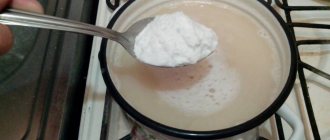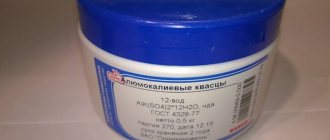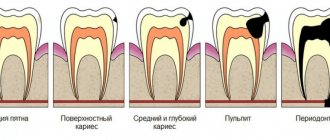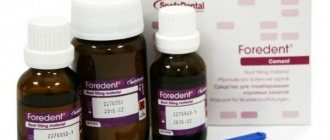ARSENIC
is a chemical element of group V of the periodic table, belongs to the nitrogen family. Relative atomic mass 74.9216. In nature, arsenic is represented by only one stable nuclide 75As. More than ten of its radioactive isotopes with half-lives from several minutes to several months have also been artificially obtained. Typical oxidation states in compounds are –3, +3, +5. The name of arsenic in Russian is associated with the use of its compounds to exterminate mice and rats; The Latin name Arsenicum comes from the Greek “arsen” - strong, powerful.
STRUCTURE
The crystal structure of arsenic is ditrigonal-scalenohedral symmetry. Trigonal syngony, c. With. L633L23PC. The crystals are extremely rare and have a rhombohedral or pseudocubic habit.
Several allotropic modifications of arsenic have been identified. Under normal conditions, metallic or gray arsenic (alpha arsenic) is stable. The crystal lattice of gray arsenic is rhombohedral, layered, with a period a = 4.123 A, angle a = 54° 10′. Density (at a temperature of 20° C) 5.72 g/cm3; temperature coefficient linear expansion 3.36 • 10 degrees; specific electrical resistance (temperature 0° C) 35 • 10-6 ohm • cm; NV = f 147; coefficient compressibility (at a temperature of 30° C) 4.5 x 10-6cm2/kg. The melting point of alpha-arsenic is 816 ° C at a pressure of 36 atmospheres.
Under atm. Arsenic sublimes under pressure at a temperature of 615° C without melting. Heat of sublimation 102 cal/g. Arsenic vapors are colorless, up to a temperature of 800°C they consist of As4 molecules, from 800 to 1700°C - from a mixture of As4 and As2, above a temperature of 1700°C - only from As2. With the rapid condensation of arsenic vapor on a surface cooled by liquid air, yellow arsenic is formed - transparent soft crystals of a cubic system with a density of 1.97 g/cm3. Other metastable modifications of arsenic are also known: beta-arsenic - amorphous glassy, gamma-arsenic - yellow-brown and delta-arsenic - brown amorphous with densities of 4.73, respectively; 4.97 and 5.10 g/cm3. Above a temperature of 270° C, these modifications turn into gray arsenic.
Being in nature
Arsenic is a trace element. The content in the earth's crust is 1.7·10-4% by mass. This substance can occur in a native state and has the appearance of metallic shiny gray shells or dense masses consisting of small grains. About 200 arsenic-containing minerals are known. It is often found in small concentrations in lead, copper and silver ores. Two natural compounds of arsenic and sulfur are quite common: orange-red transparent realgar AsS and lemon-yellow orpiment As2S3. A mineral of industrial importance is arsenopyrite (arsenic pyrite) FeAsS or FeS2•FeAs2; arsenic pyrite - löllingite (FeAs2) is also mined.
PROPERTIES
The color on a fresh fracture is zinc-white, tin-white to light gray, quickly fades due to the formation of dark gray tarnish; black on a weathered surface. Hardness on the Mohs scale 3 - 3.5. Density 5.63 - 5.8 g/cm3. Fragile. Diagnosed by the characteristic smell of garlic when struck. Cleavage is perfect along {0001} and less perfect along {0112}. The fracture is grainy. Ud. weight 5.63-5.78. The line is gray, pewter-white. The luster is metallic, strong (when freshly fractured), quickly fades and becomes dull on an oxidized surface that has become blackened over time. Is diamagnetic.
Poisoning
Acute poisoning with various M compounds is severe.
There are three forms of acute poisoning by M.
When poison enters the stomach (for example, in case of poisoning with insecticides, etc.), the most likely condition is gall. form. Moreover, during the first 0.5-2 hours. victims note a metallic taste, scratching and burning sensation in the mouth. Severe pain in the abdomen begins, uncontrollable vomiting. Vomit is most often yellow-green in color, sometimes containing a white “core” of undissolved M. After a few hours, the vomiting ends, but the abdominal pain does not stop. Already on the first day, the picture of this form of acute M. poisoning resembles cholera. There is painful diarrhea (stool resembles rice water), severe dehydration occurs, urine output decreases, sometimes to complete anuria (see). The victim's voice becomes hoarse, cramps increase (especially in the calves), cyanosis, collapse (see). Death may occur within days or even hours.
The second form of acute poisoning with M. compounds—paralytic—is observed when large quantities of poison (from 0.06 g or more) enter the body through various routes. Characterized by general weakness, painful convulsions, loss of consciousness, coma, paralysis of the respiratory and vasomotor centers. Death can occur in a few hours, at the latest in a day, without the appearance of disorders from the gastrointestinal tract. tract.
The third form of acute poisoning is observed when inhaling dust from compounds of M. (for example, when treating seeds, mining ore containing M., etc.) or arsenous hydrogen. When exposed to M. dust, the conjunctiva and mucous membranes of the respiratory tract are first affected, and sometimes hemoptysis occurs. If proper measures are not taken, all symptoms intensify, severe headaches occur, and sometimes nosebleeds. It is noted that an early symptom of this form of acute poisoning with M. compounds is a dull pain in the arms and legs. As the condition worsens, a sweet taste in the mouth, nausea, vomiting, abdominal pain, a feeling of heat and itching in the genital area appear. The nervous system is affected - trembling, convulsions. The prognosis for this form of acute poisoning is relatively favorable, but the consequences of a one-time poisoning can be felt within a month.
Acute poisoning with arsenic hydrogen, according to the wedge, does not differ in picture from poisoning caused by inhalation of other compounds of M., which is explained by its hemolytic effect. The first symptoms of AsH3 poisoning are general malaise, vomiting, jaundice, red urine (due to hemolysis of the blood), and the amount of urine is reduced. In severe cases, the content of red blood cells and hemoglobin in the blood is sharply reduced. The mortality rate for acute poisoning with arsenic hydrogen reaches 30%.
First aid and emergency therapy. In case of poisoning with M. compounds, immediate hospitalization is required if possible. Emergency treatment for AsH3 poisoning involves replacement blood transfusion with intravenous infusion of 40% glucose solution (10-20 ml), combating anemia and renal failure; in severe cases - an artificial kidney. In case of acute poisoning per os, urgent measures are taken aimed at quickly removing M. from the body and neutralizing it (emetics, gastric lavage with warm water, a suspension of magnesium oxide - 20 g per 1 liter of water). Then Antidotum arsenici (100 parts of ferrous sulfate solution with a density of 1.43 per 300 parts of cold water) is introduced, 1 teaspoon. l. every 10-12 minutes. until vomiting stops completely. Antidotum metallorum is also used (in 100 ml of water 0.5-0.7 g of hydrogen sulfide, 0.1 g of sodium hydroxide, 0.38 g of sulfate and 1.25 g of sodium bicarbonate): 200 ml of water is injected into the stomach, then 100 ml antidote, after which the stomach is washed. Prescribed intravenously 20 ml of 25-40% glucose solution with ascorbic acid (500 mg) and vitamin B1 (50 mg), drip enemas of 5% glucose solution, fiziol, solution under the skin, camphor, caffeine , oxygen therapy. Treatment with dithiol drugs should be started as early as possible, which include lipoic acid (see), BAL, unithiol (see Antidotes of OV).
For the treatment of necrobiotic lesions on the skin, it is recommended to take orally ascorbic acid, vitamin A (100,000 IU per day), sodium thiosulfate (intravenously), cold lotions (lead, with drilling fluid, etc.), zinc talkers, hydrocortisone ointment, streptocidal and synthomycin emulsion, etc. For inflammation of the conjunctiva or cornea, use 5% BAL solution or 5% unithiol solution locally; for blepharitis, use an ointment containing these substances.
MORPHOLOGY
Arsenic is usually observed in the form of crusts with a sintered kidney-shaped surface, stalactites, shell-like formations, which reveal a crystalline-granular structure when fractured. Native arsenic is quite easily recognized by the shape of the deposits, blackened surface, significant specific gravity, strong metallic luster in a fresh fracture and perfect cleavage. Under the blowpipe it evaporates without melting (at a temperature of about 360°), emitting a characteristic garlic odor and forming a white As2O3 coating on the coal. It turns into a liquid state only at increased external pressure. In a closed tube it forms a mirror of arsenic. When struck sharply with a hammer, it emits a garlicky smell.
Interesting Facts
There are a lot of interesting facts related to arsenic. It is worth starting with the fact that arsenic is a toxic substance and poses a serious danger to human health. In history, it was often used to poison high-ranking and influential figures of the time. Due to the fact that arsenic poisoning could not be recognized until 1836 (the discovery of the Marsh sample). An example is a figure like Napoleon. Experts for some time assumed that the military commander was poisoned with arsenic due to its high concentration in his hair.
Another significant figure is Grigory Rasputin. They tried to poison him with arsenic, but the attempt was a failure. Rasputin knew that they were going to poison him and began to take this element in small doses and thus achieved immunity to this poison. Because of this event, Grigory Rasputin earned himself the reputation of a witcher and occultist. Due to the huge number of poisonings in high-ranking circles, mvshyak was nicknamed “poison of kings” or “royal poison”.
Another interesting point is that in 1858, mass arsenic poisoning occurred in the English city of Bradford. The poisonous element was added to sweets that were sold in an ordinary street shop. As a result of this poisoning, 21 people died, and more than 200 were poisoned.
ORIGIN
Arsenic occurs in hydrothermal deposits as metacolloidal formations in voids, apparently formed during the last moments of hydrothermal activity. In association with it, arsenic, antimonous, and, less commonly, sulfur compounds of nickel, cobalt, silver, lead, etc., of various compositions, as well as non-metallic minerals, can be found.
In the literature there are indications of the secondary origin of arsenic in weathering zones of arsenic ore deposits, which, generally speaking, is unlikely, given that under these conditions it is very unstable and, quickly oxidizing, decomposes completely. The black crusts consist of a fine mixture of arsenic and arsenolite (As2O3). Eventually pure arsenolite is formed.
In the earth's crust, the concentration of arsenic is low and amounts to 1.5 ppm. It is found in soil and minerals and can be released into the air, water and soil through wind and water erosion. In addition, the element enters the atmosphere from other sources. As a result of volcanic eruptions, about 3 thousand tons of arsenic are released into the air per year, microorganisms produce 20 thousand tons of volatile methylarsine per year, and as a result of the combustion of fossil fuels, 80 thousand tons are released over the same period.
On the territory of the USSR, native arsenic was found in several deposits. Of these, we note the Sadon hydrothermal lead-zinc deposit, where it was repeatedly observed in the form of kidney-shaped masses on crystalline calcite with galena and sphalerite. Large kidney-shaped accumulations of native arsenic with a concentric shell-like structure were found on the left bank of the river. Chikoya (Transbaikalia). In paragenesis with it, only calcite was observed in the form of rims on the walls of thin veins cutting across ancient crystalline schists. In the form of fragments (Fig. 76), arsenic was also found in the area of st. Jalinda, Amurskaya railway etc. and in other places.
In a number of deposits in Saxony (Freiberg, Schneeberg, Annaberg, etc.), native arsenic was observed in association with arsenic compounds of cobalt, nickel, silver, native bismuth, etc. All these and other finds of this mineral are of no practical significance.
Determination of arsenic.
A qualitative reaction to arsenic is the precipitation of yellow sulfide As2S3 from hydrochloric acid solutions. Traces are determined by the Marsh reaction or the Gutzeit method: strips of paper soaked in HgCl2 darken in the presence of arsine, which reduces sublimate to mercury.
In recent decades, various sensitive analytical methods have been developed that can quantify minute concentrations of arsenic, for example in natural waters. These include flame atomic absorption spectrometry, atomic emission spectrometry, mass spectrometry, atomic fluorescence spectrometry, neutron activation analysis... If there is very little arsenic in the water, pre-concentration of the samples may be necessary. Using such concentration, a group of Kharkov scientists from the National Academy of Sciences of Ukraine developed in 1999 an extraction-X-ray fluorescence method for determining arsenic (as well as selenium) in drinking water with a sensitivity of up to 2.5–5 μg/l.
For the separate determination of As(III) and As(V) compounds, they are first separated from each other using well-known extraction and chromatographic methods, as well as using selective hydrogenation. Extraction is usually carried out using sodium dithiocarbamate or ammonium pyrrolidine dithiocarbamate. These compounds form water-insoluble complexes with As(III), which can be extracted with chloroform. The arsenic can then be converted back into the aqueous phase by oxidation with nitric acid. In the second sample, arsenate is converted to arsenite using a reducing agent, and then a similar extraction is performed. This is how “total arsenic” is determined, and then by subtracting the first result from the second, As(III) and As(V) are determined separately. If there are organic arsenic compounds in water, they are usually converted to methyldiodarsine CH3AsI2 or dimethyliodarsine (CH3)2AsI, which are determined by one or another chromatographic method. Thus, using high-performance liquid chromatography, nanogram quantities of a substance can be determined.
Many arsenic compounds can be analyzed using the so-called hydride method. It involves the selective reduction of the analyte into volatile arsine. Thus, inorganic arsenites are reduced to AsH3 at pH 5 – 7, and at pH
The neutron activation method is also sensitive. It consists of irradiating a sample with neutrons, while 75As nuclei capture neutrons and transform into the radionuclide 76As, which is detected by characteristic radioactivity with a half-life of 26 hours. This way you can detect up to 10–10% arsenic in a sample, i.e. 1 mg per 1000 tons of substance
APPLICATION
Arsenic is used to alloy lead alloys used to prepare shot, since when shot is cast using the tower method, drops of the arsenic-lead alloy acquire a strictly spherical shape, and in addition, the strength and hardness of lead increases significantly. Arsenic of special purity (99.9999%) is used for the synthesis of a number of useful and important semiconductor materials - arsenides (for example, gallium arsenide) and other semiconductor materials with a crystal lattice such as zinc blende.
Arsenic sulfide compounds - orpiment and realgar - are used in painting as paints and in the leather industry as agents for removing hair from the skin. In pyrotechnics, realgar is used to produce “Greek” or “Indian” fire, which occurs when a mixture of realgar with sulfur and nitrate burns (when burned, it forms a bright white flame). Some organoelement compounds of arsenic are chemical warfare agents, for example, lewisite.
At the beginning of the 20th century, some cacodyl derivatives, for example, salvarsan, were used to treat syphilis; over time, these drugs were displaced from medical use for the treatment of syphilis by other, less toxic and more effective, pharmaceutical drugs that do not contain arsenic.
Many of the arsenic compounds in very small doses are used as drugs to combat anemia and a number of other serious diseases, as they have a clinically noticeable stimulating effect on a number of specific functions of the body, in particular, on hematopoiesis. Of the inorganic arsenic compounds, arsenous anhydride can be used in medicine for the preparation of pills and in dental practice in the form of a paste as a necrotizing drug. This drug was colloquially and colloquially called “arsenic” and was used in dentistry for local necrosis of the dental nerve. Currently, arsenic preparations are rarely used in dental practice due to their toxicity. Now other methods of painless necrosis of the tooth nerve under local anesthesia have been developed and are being used.
Arsenic - As
| Molecular weight | 74.92 g/mol |
| origin of name | Russian name from the word “mouse”, in connection with the use of its compounds to exterminate mice and rats. English from Greek. Arsenikon, originally applied to the mineral orpiment |
| IMA status | valid |
Receipt
The discovery of a method for producing the so-called metallic arsenic (gray arsenic) is attributed to the famous medieval alchemist Albertus Magnus, who lived in the 13th century. However, much earlier, Greek and Arab alchemists were able to obtain arsenic in free form by heating “white arsenic” (the fact that this is arsenic trioxide, and not a simple substance, was revealed only in 1789 by A. L. Lavoisier, who gave the name to the element "Arsenicum") with various organic substances. There are many ways to obtain arsenic: by sublimation of natural arsenic, by thermal decomposition of arsenic pyrite, by reduction of arsenic anhydride, etc.
PHYSICAL PROPERTIES
| Mineral color | pewter-white, fading to dark gray or black on the surface |
| Stroke color | grey |
| Transparency | opaque |
| Shine | semi-metallic, dull |
| Cleavage | perfect by {0001} and less perfect by {0112} |
| Hardness (Mohs scale) | 3,5 |
| Kink | uneven |
| Strength | fragile |
| Density (measured) | 5.63 – 5.78 g/cm3 |
| Radioactivity (GRapi) | 0 |
Indications
Indications for the use of anesthetic drugs based on arsenic:
- impossibility of using other anesthetics (for a number of indications);
- resistance to other local anesthetics;
- inability to use local or conduction anesthesia (for a number of indications);
- treatment of older children (provided the root system is formed);
- sharp throbbing pain in the affected area of the tooth.
The advisability of using arsenic paste is determined by the doctor after assessing the patient’s oral cavity, the stage of tooth damage, the severity of symptoms and studying the patient’s medical history.
Contraindications for use
Despite the fact that arsenic is used in small doses, there are a number of contraindications for use:
- individual intolerance to arsenic or other components of the paste;
- early childhood (up to 1.5 - 2 years);
- aggravated clinical history of the patient (anomalies in the development of organs and systems, pathological conditions);
- incomplete process of root system formation;
- impossibility of expansion and drainage of root canals;
- abnormal structure of the root system;
- osteoperforation of the root and hilar region;
- chronic increase in intraocular pressure (risks of developing glaucoma);
- diseases of the urinary system (pyelonephritis, hydronephrosis, cystitis, prostatitis, etc.);
- gestational period in women (all trimesters) and lactation.
The use of arsenic should be carried out in strict accordance with the recommended dosage. When applying arsenic paste, it is important to follow the advice of specialists and be sure to comply with the treatment time frame.
Diagnostics
Drug-induced periodontitis does not have specific symptoms, so it should be distinguished from other inflammatory periodontal diseases. A distinctive feature of drug-induced periodontitis is that the pain appeared after the acute symptoms subsided, after some time of “calm”, which was preceded by the application of a devitalizing paste - normally, a person, on the contrary, should experience relief.
This is interesting: Why does the temperature rise after tooth extraction and what to do?
Dental radiography can be used as an additional examination method - in the image you can see the focus of bone loss around the root of the diseased tooth. The patient should carefully listen to his feelings during the treatment of periodontitis, since early detection of the disease allows for faster relief from symptoms and prevents the development of complications.
Usage algorithm
The application of the drug and temporary filling is carried out in 3 stages:
- pulp opening;
- removal of damaged dentin;
- application of arsenic paste.
For single-rooted teeth, the duration of application reaches 24 hours, for multi-rooted teeth - 48 hours. Once the installation is complete, the doctor will schedule the next appointment.
This is interesting: How long should you not eat or drink after extraction - how many hours later can you eat after tooth extraction
The next appointment should be scheduled no later than the time it is safe to wear a temporary filling with arsenic. Leaving the paste in the tooth cavity threatens serious complications and can provoke further destruction.
Installation
The procedure for your first visit is as follows:
- The doctor refers the patient to X-ray diagnostics of the diseased tooth. Having received the photo, he, focusing on it, will open the carious cavity. Then the inside of the tooth is cleaned of dead tissue.
- Then arsenic is placed on the site. A small cotton ball soaked in an anesthetic can be placed on top of it, which should relieve discomfort.
- The inside of the tooth is then sealed with a temporary filling to prevent dirt from getting in. The patient is released for 1.5-2 days. The doctor will tell you the exact number of days when scheduling the next visit.
Usually, the patient is advised to call if particularly severe pain occurs. If medications do not help and the condition worsens sharply, the doctor may advise you to go to the nearest dental department and remove the temporary filling, or do it yourself.
Arsenic installation process
Extraction
At the second appointment, the dentist removes the temporary filling. The cavity inside the tooth is carefully processed and then cleaned of arsenic residues. Then the doctor, having checked the sensitivity of the nerve, proceeds to remove it.
To make sure that the arsenic has been completely removed, a dye is added to the preparation before installing it, making the substance easy to see on the walls of the tooth.
Self extraction
If for any reason after applying the drug, prolonged pain appears, this means that the negative effect of arsenic has spread further to healthy tissues. In order not to delay removing the filling and paste, the patient can do it himself.
First, remove the filling itself: they are made of soft materials and are easily pryed off with a needle. The paste itself is also cleaned with a sharp, thin object (tweezers).
The main task is not to ingest arsenic during cleaning. Any instrument must first be disinfected, and then cover the open area with a cotton ball or swab.
Then the oral cavity should be rinsed with a solution of soda, iodine or hydrogen peroxide. Plus, you can rinse your mouth with milk - it also helps to neutralize any remaining substances. Afterwards, you should visit your doctor as soon as possible to avoid complications.
Etymology
The name of arsenic in Russian comes from the word “mouse”, in connection with the use of its compounds to exterminate mice and rats. The Greek name ἀρσενικόν comes from the Persian زرنيخ (zarnik) - “yellow orpiment.” Folk etymology dates back to ancient Greek. ἀρσενικός - male.
Latin name arsenicum
is a direct borrowing of the Greek ἀρσενικόν.
In 1789, A. Lavoisier included arsenic in the list of chemical elements under the name arsenic
.
Analogs
The main analogue of arsenic is paraformaldehyde paste.
When using acceptable concentrations, its active substance has a depressing effect on the development of pathogenic microflora. If the dosage is exceeded, paraformaldehyde paste causes necrotic changes in soft tissues and jaw bone. Preparations based on paraformaldehyde have a less toxic effect and are safer for the body. The composition of these drugs consists of anesthetics (for example, anesthesin or trimecaine) and clove oil (eugenol). Medicines with paraformaldehyde are prescribed for a period of 6 to 14 days. There are arsenic-free pastes available in 3 types - A, P, C:
- A - with an antiseptic and anesthetic;
- P - used in the treatment of baby teeth without removing the pulp;
- C - used for complete removal of the pulp after it has died.
Sources
- https://dr-zubov.ru/xirurgiya/udalenie-nerva/osobennosti-myshyaka.html
- https://www.vash-dentist.ru/hirurgiya/udalenie-nerva/ispolzovanie-myishyaka-v-stomatologii.html
- https://dentoland.com/lechenie/skolko-mozhno-derzhat-myshyak-v-zube.html
- https://infozub.ru/lechenie/myshyak-v-zube.htm
- https://osp-sakhalin.ru/drugoe/myshyak-v-zube.html
- https://karies.pro/zuby/periodontit/myshyakovistiy-periodontit.html
- https://dlja-pohudenija.ru/otravlenie/otravlenie-myshyakom-simptomy-lechenie-profilaktika











